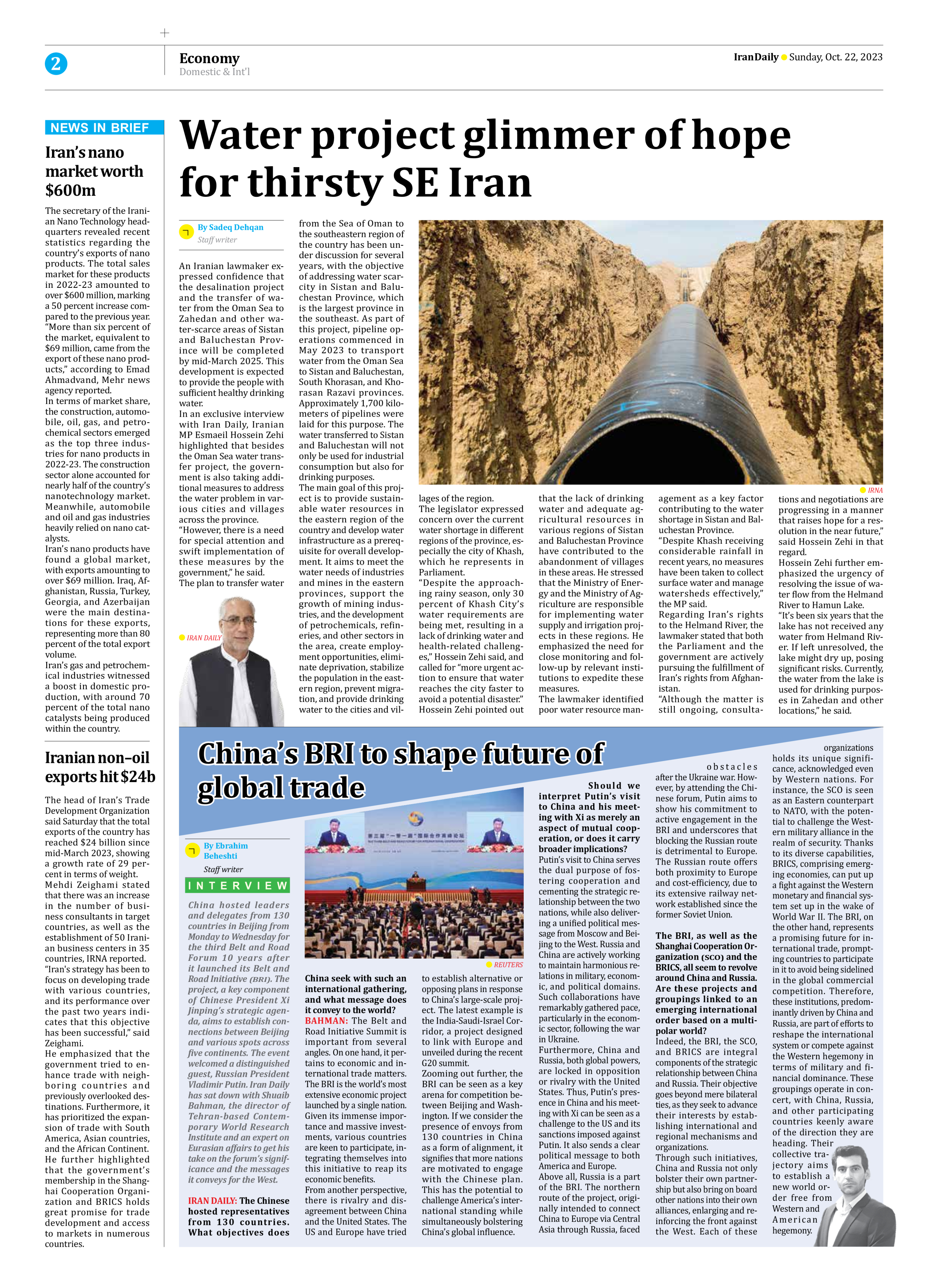
China’s BRI to shape future of global trade
By Ebrahim Beheshti
Staff writer
China hosted leaders and delegates from 130 countries in Beijing from Monday to Wednesday for the third Belt and Road Forum 10 years after it launched its Belt and Road Initiative (BRI). The project, a key component of Chinese President Xi Jinping’s strategic agenda, aims to establish connections between Beijing and various spots across five continents. The event welcomed a distinguished guest, Russian President Vladimir Putin. Iran Daily has sat down with Shuaib Bahman, the director of Tehran-based Contemporary World Research Institute and an expert on Eurasian affairs to get his take on the forum’s significance and the messages it conveys for the West.
Iran Daily: The Chinese hosted representatives from 130 countries. What objectives does China seek with such an international gathering, and what message does it convey to the world?
Bahman: The Belt and Road Initiative Summit is important from several angles. On one hand, it pertains to economic and international trade matters. The BRI is the world’s most extensive economic project launched by a single nation. Given its immense importance and massive investments, various countries are keen to participate, integrating themselves into this initiative to reap its economic benefits.
From another perspective, there is rivalry and disagreement between China and the United States. The US and Europe have tried to establish alternative or opposing plans in response to China’s large-scale project. The latest example is the India-Saudi-Israel Corridor, a project designed to link with Europe and unveiled during the recent G20 summit.
Zooming out further, the BRI can be seen as a key arena for competition between Beijing and Washington. If we consider the presence of envoys from 130 countries in China as a form of alignment, it signifies that more nations are motivated to engage with the Chinese plan. This has the potential to challenge America’s international standing while simultaneously bolstering China’s global influence.
Should we interpret Putin’s visit to China and his meeting with Xi as merely an aspect of mutual cooperation, or does it carry broader implications?
Putin’s visit to China serves the dual purpose of fostering cooperation and cementing the strategic relationship between the two nations, while also delivering a unified political message from Moscow and Beijing to the West. Russia and China are actively working to maintain harmonious relations in military, economic, and political domains. Such collaborations have remarkably gathered pace, particularly in the economic sector, following the war in Ukraine.
Furthermore, China and Russia, both global powers, are locked in opposition or rivalry with the United States. Thus, Putin’s presence in China and his meeting with Xi can be seen as a challenge to the US and its sanctions imposed against Putin. It also sends a clear political message to both America and Europe.
Above all, Russia is a part of the BRI. The northern route of the project, originally intended to connect China to Europe via Central Asia through Russia, faced
obstacles
after the Ukraine war. However, by attending the Chinese forum, Putin aims to show his commitment to active engagement in the BRI and underscores that blocking the Russian route is detrimental to Europe. The Russian route offers both proximity to Europe and cost-efficiency, due to its extensive railway network established since the former Soviet Union.
The BRI, as well as the Shanghai Cooperation Organization (SCO) and the BRICS, all seem to revolve around China and Russia. Are these projects and groupings linked to an emerging international order based on a multipolar world?
Indeed, the BRI, the SCO, and BRICS are integral components of the strategic relationship between China and Russia. Their objective goes beyond mere bilateral ties, as they seek to advance their interests by establishing international and regional mechanisms and organizations.
Through such initiatives, China and Russia not only bolster their own partnership but also bring on board other nations into their own alliances, enlarging and reinforcing the front against the West. Each of these
organizations holds its unique significance, acknowledged even by Western nations. For instance, the SCO is seen as an Eastern counterpart to NATO, with the potential to challenge the Western military alliance in the realm of security. Thanks to its diverse capabilities, BRICS, comprising emerging economies, can put up a fight against the Western monetary and financial system set up in the wake of World War II. The BRI, on the other hand, represents a promising future for international trade, prompting countries to participate in it to avoid being sidelined in the global commercial competition. Therefore, these institutions, predominantly driven by China and Russia, are part of efforts to reshape the international system or compete against the Western hegemony in terms of military and financial dominance. These groupings operate in concert, with China, Russia, and other participating countries keenly aware of the direction they are heading. Their collective trajectory aims to establish a new world order free from Western and American hegemony.







